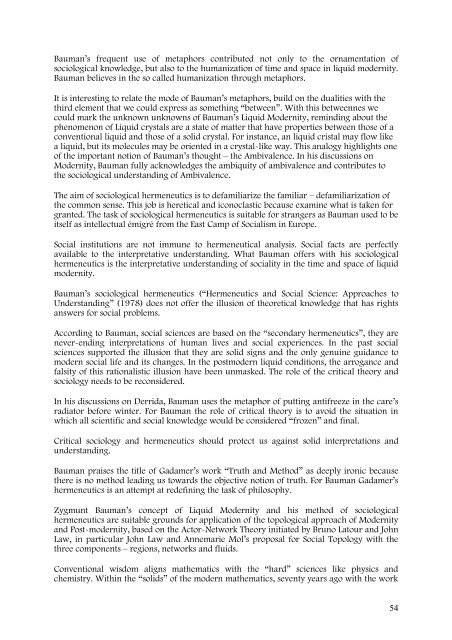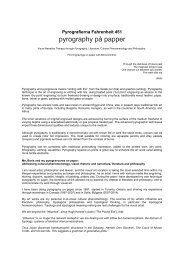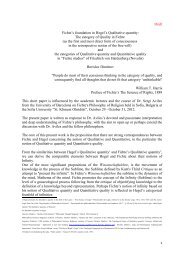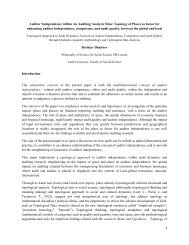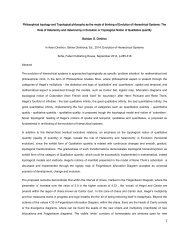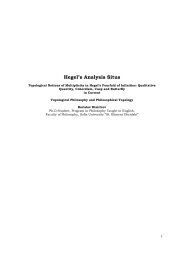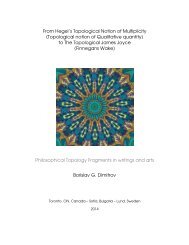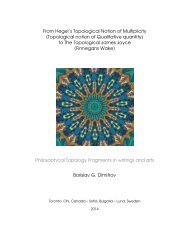Topological Ontology and Logic of Qualitative quantity
Qualitative quantity and BFO (Basic Formal Ontology) of /Barry Smith/ and YAMATO (Yet Another More Advanced Top-level Ontology) of /Riichiro Mizoguchi/
Qualitative quantity and BFO (Basic Formal Ontology) of /Barry Smith/ and YAMATO (Yet Another More Advanced Top-level Ontology) of /Riichiro Mizoguchi/
- No tags were found...
Create successful ePaper yourself
Turn your PDF publications into a flip-book with our unique Google optimized e-Paper software.
Bauman’s frequent use <strong>of</strong> metaphors contributed not only to the ornamentation <strong>of</strong><br />
sociological knowledge, but also to the humanization <strong>of</strong> time <strong>and</strong> space in liquid modernity.<br />
Bauman believes in the so called humanization through metaphors.<br />
It is interesting to relate the mode <strong>of</strong> Bauman’s metaphors, build on the dualities with the<br />
third element that we could express as something “between”. With this betweennes we<br />
could mark the unknown unknowns <strong>of</strong> Bauman’s Liquid Modernity, reminding about the<br />
phenomenon <strong>of</strong> Liquid crystals are a state <strong>of</strong> matter that have properties between those <strong>of</strong> a<br />
conventional liquid <strong>and</strong> those <strong>of</strong> a solid crystal. For instance, an liquid cristal may flow like<br />
a liquid, but its molecules may be oriented in a crystal-like way. This analogy highlights one<br />
<strong>of</strong> the important notion <strong>of</strong> Bauman’s thought – the Ambivalence. In his discussions on<br />
Modernity, Bauman fully acknowledges the ambiquity <strong>of</strong> ambivalence <strong>and</strong> contributes to<br />
the sociological underst<strong>and</strong>ing <strong>of</strong> Ambivalence.<br />
The aim <strong>of</strong> sociological hermeneutics is to defamiliarize the familiar – defamiliarization <strong>of</strong><br />
the common sense. This job is heretical <strong>and</strong> iconoclastic because examine what is taken for<br />
granted. The task <strong>of</strong> sociological hermeneutics is suitable for strangers as Bauman used to be<br />
itself as intellectual émigré from the East Camp <strong>of</strong> Socialism in Europe.<br />
Social institutions are not immune to hermeneutical analysis. Social facts are perfectly<br />
available to the interpretative underst<strong>and</strong>ing. What Bauman <strong>of</strong>fers with his sociological<br />
hermeneutics is the interpretative underst<strong>and</strong>ing <strong>of</strong> sociality in the time <strong>and</strong> space <strong>of</strong> liquid<br />
modernity.<br />
Bauman’s sociological hermeneutics (“Hermeneutics <strong>and</strong> Social Science: Approaches to<br />
Underst<strong>and</strong>ing” (1978) does not <strong>of</strong>fer the illusion <strong>of</strong> theoretical knowledge that has rights<br />
answers for social problems.<br />
According to Bauman, social sciences are based on the “secondary hermeneutics”, they are<br />
never-ending interpretations <strong>of</strong> human lives <strong>and</strong> social experiences. In the past social<br />
sciences supported the illusion that they are solid signs <strong>and</strong> the only genuine guidance to<br />
modern social life <strong>and</strong> its changes. In the postmodern liquid conditions, the arrogance <strong>and</strong><br />
falsity <strong>of</strong> this rationalistic illusion have been unmasked. The role <strong>of</strong> the critical theory <strong>and</strong><br />
sociology needs to be reconsidered.<br />
In his discussions on Derrida, Bauman uses the metaphor <strong>of</strong> putting antifreeze in the care’s<br />
radiator before winter. For Bauman the role <strong>of</strong> critical theory is to avoid the situation in<br />
which all scientific <strong>and</strong> social knowledge would be considered “frozen” <strong>and</strong> final.<br />
Critical sociology <strong>and</strong> hermeneutics should protect us against solid interpretations <strong>and</strong><br />
underst<strong>and</strong>ing.<br />
Bauman praises the title <strong>of</strong> Gadamer’s work “Truth <strong>and</strong> Method” as deeply ironic because<br />
there is no method leading us towards the objective notion <strong>of</strong> truth. For Bauman Gadamer’s<br />
hermeneutics is an attempt at redefining the task <strong>of</strong> philosophy.<br />
Zygmunt Bauman’s concept <strong>of</strong> Liquid Modernity <strong>and</strong> his method <strong>of</strong> sociological<br />
hermeneutics are suitable grounds for application <strong>of</strong> the topological approach <strong>of</strong> Modernity<br />
<strong>and</strong> Post-modernity, based on the Actor-Network Theory initiated by Bruno Latour <strong>and</strong> John<br />
Law, in particular John Law <strong>and</strong> Annemarie Mol’s proposal for Social Topology with the<br />
three components – regions, networks <strong>and</strong> fluids.<br />
Conventional wisdom aligns mathematics with the “hard” sciences like physics <strong>and</strong><br />
chemistry. Within the “solids” <strong>of</strong> the modern mathematics, seventy years ago with the work<br />
54


